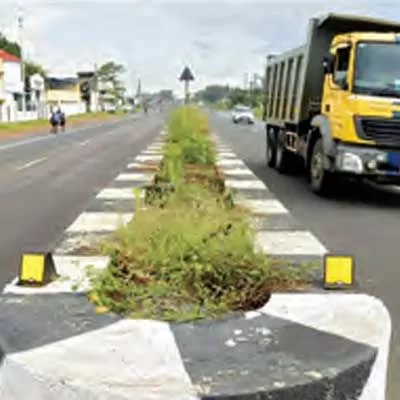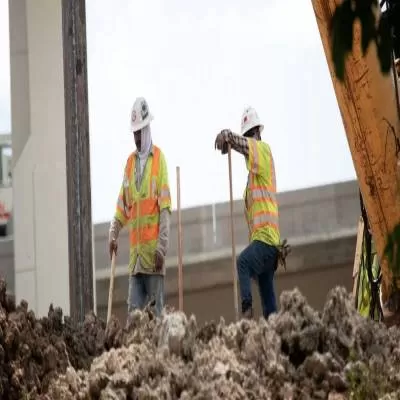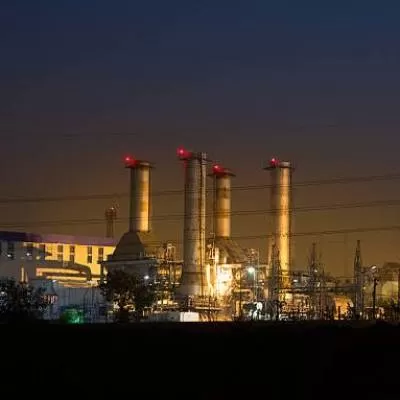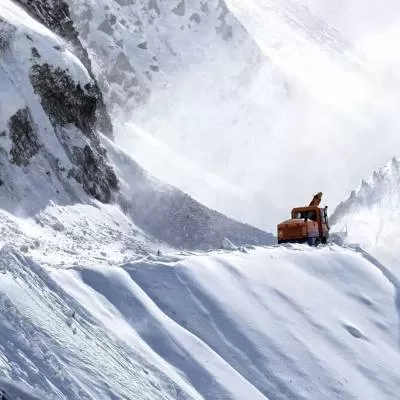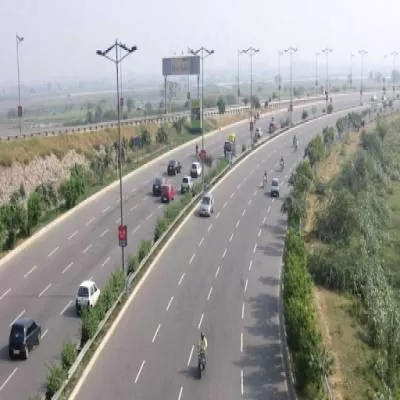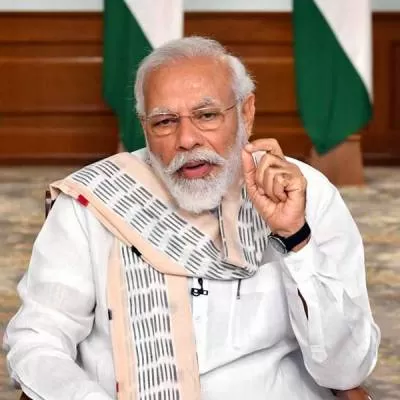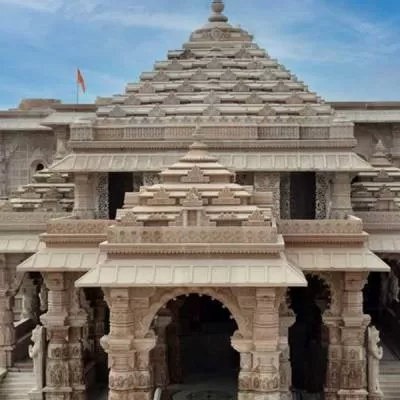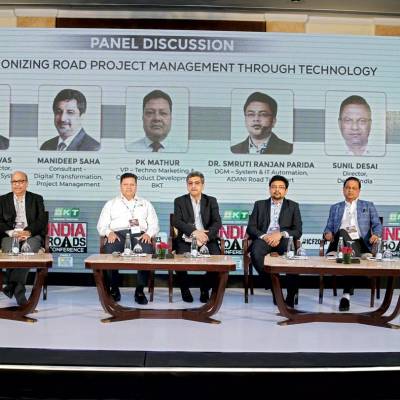- Home
- Infrastructure Transport
- ROADS & HIGHWAYS
- Good Intentions Pave The Highway Sector...

Good Intentions Pave The Highway Sector...
With the Narendra Modi Government proposing to award Rs 500,000 crore worth of highway contracts in the last two years of its tenure, road construction companies are upbeat about the upcoming opportunities, which will span India.
'We are delighted about the 20,000 km of road projects coming up in the remaining two years of the present government,' says Anil Kumar Singh, Managing Director, Apco Infratech. 'The char dham connectivity programme is one of the best upcoming opportunities; it marks a shift from building roads to facilitate commercial vehicle movements to making roads for improving connectivity for pilgrimage purposes.'
'With the government targeting 90,000 km road construction in its tenure, a big opportunity lies ahead for every player in the road construction industry, for which we are well prepared,' says Ashish Patel, Director, Ashish Infracon. 'The economic corridor includes a length of about 21,000 km as well as 14,000 km of feeder routes, and as such will span a huge geography.'
'This government is fully committed to bridge India's infrastructure deficit, consistently investing in highways and other transport infrastructure to accelerate economic growth,' says Jayant D Mhaiskar, Vice Chairman & Managing Director, MEP Infrastructure Developers.
Clearly, the industry has the bandwidth to take on more work. However, some caveats are associated with fast-paced road building. Whereas CK Thakur, CEO and President, Buildings, Infrastructure and Power, Punj Lloyd Group, believes these ambitious targets of a huge country on the rapid development path are feasible and achievable. He urges caution to ensure that quality infrastructure is created and sustainable design and safety are not compromised, saying, 'India has long suffered at the hands of poor quality and lack of design thinking, which should be addressed today.'
Overambitious targets
Notwithstanding the industry's enthusiasm, judging by the recent performance of the roads sector, the government appears unlikely to meet these ambitious targets. 'The NHAI's construction target for fiscal 2017 was 3.7 times its achievement in the previous fiscal, 8,000 km versus 2,196 km, but at around 2,650 km, the actual execution fell considerably short,' observes Binaifer Jehani, Director, CRISIL Research.
'The project award target for 2017 was 3.4 times its achievement in the previous fiscal, 15,000 km versus 4,350 km, but the actual award was barely 4,336 km respectively.'
So, what are the hurdles to achieving these targets?
The answer lies in the long-drawn process leading up to the award of a project, responds Jehani. 'Before a bid is invited for any project, a detailed project report (DPR) has to be prepared and the required land has to be made available. These two activities, even if conducted simultaneously, require at least two to three years, thereby leading us to believe that the target set for the next two years is very high.' If the government's intention is to invite, say, bids for 20,000 km in the next two years, it should have at least 25,000 km in the DPR planning stage, agrees Singh. 'But the length of projects in the DPR stage has not been made clear.'
HAM: boon or bane?
Identifying a financial model for the 20,000 km may also present concerns, Singh says. 'A considerable number of HAM (hybrid annuity model) projects have not yet achieved financial closure owing to issues with lenders in the past eighteen months, so deciding on a model for the 20,000 km of road projects will be a tough call. Today, contractors are mostly only interested in EPC projects; barely three to four bidders came forward for recently bid HAM projects.'
'Private participation in BOT projects is low, and HAM and EPC are the primary modes of awarding for the government today,' adds Jehani. 'But new players awarded HAM projects are finding it difficult to tie up funds, thereby restricting their project participation. While financial closure for a HAM project should be achieved in 150 days, many are taking over a year owing to the lender's cautious approach towards the new PPP model.'
The industry appears divided on this aspect. According to Mhaiskar, 'HAM is an asset-light model for developers, a deferred EPC model, which allows for actual construction or EPC profit during the first two-and-a-half to three years and gives a reasonable return on the annuity side.'
HAM, the shared-risk model where the government also bears 40 per cent of the upfront project cost, is the most effective model so far, opines Patel. 'It gives confidence and great support to contractors and thereby speeds up execution of work and improves work quality. Lower traffic doesn't create any maintenance issues as the government also bears the revenue-toll collection risk, leaving the developer responsible for O&M.'
Bidding, execution delays
After the project specifications are established, land acquisition delays could slow down bidding and other clearances could slow down actual work. 'The new policy provides for bidding to happen only after the completion of the land acquisition process; besides, contractors will be able to fulfil the ambitious target in the shortest period only if all the other clearances are in place on the appointment date,' says Singh.
According to Patel, challenges will arise on account of environmental clearances, land possession, coordination with different governmental departments, and funding from financial institutions and from principals for work done. But the silver lining is that 'the government has shown its intent through policy intervention and regular follow-up with the banks'.
Clarity about land compensation and a decision to limit NGT intervention in road projects would also speed up implementation, says Singh. 'And modifying the mining policy such that mines can be allotted for specific projects and granting new mining approvals for gravel, aggregates, boulders, sand, etc, would also help.'
Two-lane projects: Attractive or not?
Giving the nod to the development of 1,120 km to two-lane standards in the states of Karnataka, Odisha, Bihar, Rajasthan and West Bengal under the National Highways Interconnectivity Improvement Project (NHIIP) is a positive step for ensuring safe, fast and all-weather movement of traffic on the proposed national highways mostly located in backward regions, thereby improving socioeconomic development. 'The Central Government's main strength recently, particularly in Maharashtra, Gujarat and Rajasthan, has been its taking over of state roads and converting them into national highways, thereby enhancing last-mile connectivity,' says Mhaiskar.
The big question: Are such projects in backward regions as appealing as other highway projects?
'NHIIP programmes are funded partly by the World Bank and the Central Government in almost equal proportion,' says Jehani. 'The projects are awarded on either EPC or item-rate contract basis and do not carry traffic risk.' However, she cautions that key concerns include delay in utility shifting by local bodies, frequent bandhs, poor law-and-order situation (especially in Naxal-infected areas), restrictions by local administrations, etc, which can considerably slow down execution. Also, if these projects are in difficult terrain, procurement of raw materials can be difficult.
What do contractors say?
'Based on our experience of working across India, I can say that one region is the same as another,' opines Thakur. 'Challenges can vary from state to state; some of them being land acquisition, availability of aggregate and an inordinately long monsoon season. Our centralised procurement group is adept at procuring at competitive rates, which helps overcome procurement-related challenges.'
'The availability of labour and material and the law-and-order situation will differ from site to site and may or may not be detrimental to the execution of the project,' says Patel.
According to Singh, 'Two-lane roads are usually associated with fewer land, forest tree cutting, environmental, relocation of local public utilities and other issues, allowing contractors to complete these projects in advance.' However, design is a critical issue in two-lane road projects as these roads see slightly higher accident rates than wider roads, he explains, which makes it crucial to develop realignment sections to suit the project and make curve improvements. Also, extra care is mandated to maintain the roads for the all-weather movement of traffic, to provide better waterways and maintain the high flood level of proposed roads.
Upswing in equipment investment
Some construction companies that have bagged projects of late, have been avidly expanding their equipment fleet. 'We have been purchasing machines for the new projects we have bagged in the past six months, worth more than Rs 500 crore, and will add more if we need to extend our fleet,' says Patel.
'We have invested Rs 30-40 crore in two ready-mix concrete plants, three crushers and two pavers for the six HAM projects we bagged last year, for which we have achieved financial closure,' says Mhaiskar. 'We are in the process of procuring other equipment.'
Others are relying on existing equipment. 'New orders do not necessitate procuring additional equipment as Punj Lloyd's rich fleet of self-owned equipment, including advanced mixers, batching plants, pavers, etc, is continuously maintained and upgraded, keeping multiple order requirements in mind,' says Thakur.
Resolving pending road project implementation issues will ensure that idle fleets are put to use. 'Various land acquisition and other issues have kept our equipment utilisation low in the past three years,' says Singh, noting that across the industry, contractors are holding huge fleets of construction equipment and are ready to increase the capital expenditure subject to the award of contracts. 'We hope our utilisation rate improves in the coming year.'
Any takers for TOT projects?
India proposes to monetise 105 highway projects for about Rs 145,000 crore in coming years as part of new innovative models of financing. One such model, the Toll Operate Transfer (TOT) model for NHAI-constructed and operated highways involves auctioning the toll-collecting right with the responsibility for maintenance and operation expectedly for 30 years. In theory, this can bring efficiency in toll collection while securing future revenues for the government. The minister has said investments will face no risk and fetch a good rate of return from highway toll collections. While CK Thakur, CEO and President, Buildings, Infrastructure and Power, Punj Lloyd Group, believes this new model is likely to attract firms specialising in highway toll collection and maintenance, not conventional road developers, it remains to be seen if those firms have the ability to bring in capital upfront. 'The appetite may vary per stretch, as each stretch will have its own risk dynamics based on local conditions and the political situation,' he says.
- Charu Bahri
To share your views on the Highways sector in India, write in at feedback@ConstructionWorld.in
But the government's ambitious targets are unlikely to materialise. With the Narendra Modi Government proposing to award Rs 500,000 crore worth of highway contracts in the last two years of its tenure, road construction companies are upbeat about the upcoming opportunities, which will span India. 'We are delighted about the 20,000 km of road projects coming up in the remaining two years of the present government,' says Anil Kumar Singh, Managing Director, Apco Infratech. 'The char dham connectivity programme is one of the best upcoming opportunities; it marks a shift from building roads to facilitate commercial vehicle movements to making roads for improving connectivity for pilgrimage purposes.' 'With the government targeting 90,000 km road construction in its tenure, a big opportunity lies ahead for every player in the road construction industry, for which we are well prepared,' says Ashish Patel, Director, Ashish Infracon. 'The economic corridor includes a length of about 21,000 km as well as 14,000 km of feeder routes, and as such will span a huge geography.' 'This government is fully committed to bridge India's infrastructure deficit, consistently investing in highways and other transport infrastructure to accelerate economic growth,' says Jayant D Mhaiskar, Vice Chairman & Managing Director, MEP Infrastructure Developers. Clearly, the industry has the bandwidth to take on more work. However, some caveats are associated with fast-paced road building. Whereas CK Thakur, CEO and President, Buildings, Infrastructure and Power, Punj Lloyd Group, believes these ambitious targets of a huge country on the rapid development path are feasible and achievable. He urges caution to ensure that quality infrastructure is created and sustainable design and safety are not compromised, saying, 'India has long suffered at the hands of poor quality and lack of design thinking, which should be addressed today.' Overambitious targets Notwithstanding the industry's enthusiasm, judging by the recent performance of the roads sector, the government appears unlikely to meet these ambitious targets. 'The NHAI's construction target for fiscal 2017 was 3.7 times its achievement in the previous fiscal, 8,000 km versus 2,196 km, but at around 2,650 km, the actual execution fell considerably short,' observes Binaifer Jehani, Director, CRISIL Research. 'The project award target for 2017 was 3.4 times its achievement in the previous fiscal, 15,000 km versus 4,350 km, but the actual award was barely 4,336 km respectively.' So, what are the hurdles to achieving these targets? The answer lies in the long-drawn process leading up to the award of a project, responds Jehani. 'Before a bid is invited for any project, a detailed project report (DPR) has to be prepared and the required land has to be made available. These two activities, even if conducted simultaneously, require at least two to three years, thereby leading us to believe that the target set for the next two years is very high.' If the government's intention is to invite, say, bids for 20,000 km in the next two years, it should have at least 25,000 km in the DPR planning stage, agrees Singh. 'But the length of projects in the DPR stage has not been made clear.' HAM: boon or bane? Identifying a financial model for the 20,000 km may also present concerns, Singh says. 'A considerable number of HAM (hybrid annuity model) projects have not yet achieved financial closure owing to issues with lenders in the past eighteen months, so deciding on a model for the 20,000 km of road projects will be a tough call. Today, contractors are mostly only interested in EPC projects; barely three to four bidders came forward for recently bid HAM projects.' 'Private participation in BOT projects is low, and HAM and EPC are the primary modes of awarding for the government today,' adds Jehani. 'But new players awarded HAM projects are finding it difficult to tie up funds, thereby restricting their project participation. While financial closure for a HAM project should be achieved in 150 days, many are taking over a year owing to the lender's cautious approach towards the new PPP model.' The industry appears divided on this aspect. According to Mhaiskar, 'HAM is an asset-light model for developers, a deferred EPC model, which allows for actual construction or EPC profit during the first two-and-a-half to three years and gives a reasonable return on the annuity side.' HAM, the shared-risk model where the government also bears 40 per cent of the upfront project cost, is the most effective model so far, opines Patel. 'It gives confidence and great support to contractors and thereby speeds up execution of work and improves work quality. Lower traffic doesn't create any maintenance issues as the government also bears the revenue-toll collection risk, leaving the developer responsible for O&M.' Bidding, execution delays After the project specifications are established, land acquisition delays could slow down bidding and other clearances could slow down actual work. 'The new policy provides for bidding to happen only after the completion of the land acquisition process; besides, contractors will be able to fulfil the ambitious target in the shortest period only if all the other clearances are in place on the appointment date,' says Singh. According to Patel, challenges will arise on account of environmental clearances, land possession, coordination with different governmental departments, and funding from financial institutions and from principals for work done. But the silver lining is that 'the government has shown its intent through policy intervention and regular follow-up with the banks'. Clarity about land compensation and a decision to limit NGT intervention in road projects would also speed up implementation, says Singh. 'And modifying the mining policy such that mines can be allotted for specific projects and granting new mining approvals for gravel, aggregates, boulders, sand, etc, would also help.' Two-lane projects: Attractive or not? Giving the nod to the development of 1,120 km to two-lane standards in the states of Karnataka, Odisha, Bihar, Rajasthan and West Bengal under the National Highways Interconnectivity Improvement Project (NHIIP) is a positive step for ensuring safe, fast and all-weather movement of traffic on the proposed national highways mostly located in backward regions, thereby improving socioeconomic development. 'The Central Government's main strength recently, particularly in Maharashtra, Gujarat and Rajasthan, has been its taking over of state roads and converting them into national highways, thereby enhancing last-mile connectivity,' says Mhaiskar. The big question: Are such projects in backward regions as appealing as other highway projects? 'NHIIP programmes are funded partly by the World Bank and the Central Government in almost equal proportion,' says Jehani. 'The projects are awarded on either EPC or item-rate contract basis and do not carry traffic risk.' However, she cautions that key concerns include delay in utility shifting by local bodies, frequent bandhs, poor law-and-order situation (especially in Naxal-infected areas), restrictions by local administrations, etc, which can considerably slow down execution. Also, if these projects are in difficult terrain, procurement of raw materials can be difficult. What do contractors say? 'Based on our experience of working across India, I can say that one region is the same as another,' opines Thakur. 'Challenges can vary from state to state; some of them being land acquisition, availability of aggregate and an inordinately long monsoon season. Our centralised procurement group is adept at procuring at competitive rates, which helps overcome procurement-related challenges.' 'The availability of labour and material and the law-and-order situation will differ from site to site and may or may not be detrimental to the execution of the project,' says Patel. According to Singh, 'Two-lane roads are usually associated with fewer land, forest tree cutting, environmental, relocation of local public utilities and other issues, allowing contractors to complete these projects in advance.' However, design is a critical issue in two-lane road projects as these roads see slightly higher accident rates than wider roads, he explains, which makes it crucial to develop realignment sections to suit the project and make curve improvements. Also, extra care is mandated to maintain the roads for the all-weather movement of traffic, to provide better waterways and maintain the high flood level of proposed roads. Upswing in equipment investment Some construction companies that have bagged projects of late, have been avidly expanding their equipment fleet. 'We have been purchasing machines for the new projects we have bagged in the past six months, worth more than Rs 500 crore, and will add more if we need to extend our fleet,' says Patel. 'We have invested Rs 30-40 crore in two ready-mix concrete plants, three crushers and two pavers for the six HAM projects we bagged last year, for which we have achieved financial closure,' says Mhaiskar. 'We are in the process of procuring other equipment.' Others are relying on existing equipment. 'New orders do not necessitate procuring additional equipment as Punj Lloyd's rich fleet of self-owned equipment, including advanced mixers, batching plants, pavers, etc, is continuously maintained and upgraded, keeping multiple order requirements in mind,' says Thakur. Resolving pending road project implementation issues will ensure that idle fleets are put to use. 'Various land acquisition and other issues have kept our equipment utilisation low in the past three years,' says Singh, noting that across the industry, contractors are holding huge fleets of construction equipment and are ready to increase the capital expenditure subject to the award of contracts. 'We hope our utilisation rate improves in the coming year.' Any takers for TOT projects? India proposes to monetise 105 highway projects for about Rs 145,000 crore in coming years as part of new innovative models of financing. One such model, the Toll Operate Transfer (TOT) model for NHAI-constructed and operated highways involves auctioning the toll-collecting right with the responsibility for maintenance and operation expectedly for 30 years. In theory, this can bring efficiency in toll collection while securing future revenues for the government. The minister has said investments will face no risk and fetch a good rate of return from highway toll collections. While CK Thakur, CEO and President, Buildings, Infrastructure and Power, Punj Lloyd Group, believes this new model is likely to attract firms specialising in highway toll collection and maintenance, not conventional road developers, it remains to be seen if those firms have the ability to bring in capital upfront. 'The appetite may vary per stretch, as each stretch will have its own risk dynamics based on local conditions and the political situation,' he says. - Charu Bahri To share your views on the Highways sector in India, write in at feedback@ConstructionWorld.in


